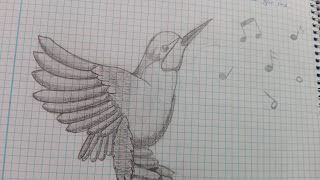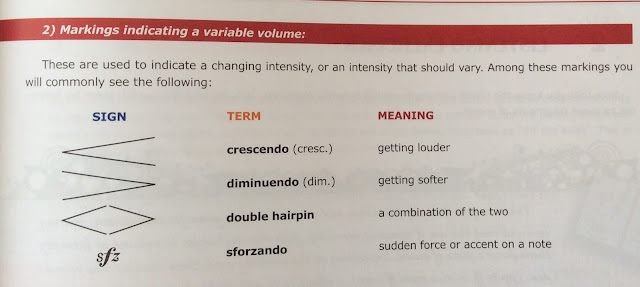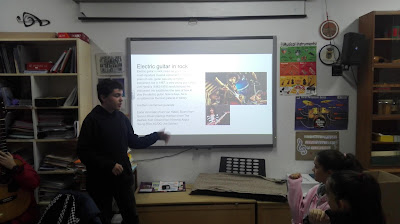1º ESO ( Sección bilingüe):
Objetivos del primer trimestre:
 |
| Carmen Tamayo´s drawing |
- Conocernos.
- Desarrollar un buen ambiente de trabajo en clase, acrecentar la motivación y continuar con nuestra curiosidad e interés por aprender.
- Desarrollar la sensibilidad al ruido y a la contaminación acústica.
- Aprender los elementos básicos de la estructura de una canción pop.
- Repasar los contenidos básicos del lenguaje musical y familiarizarnos con estos contenidos tratados en inglés.
 |
| Jiahui´s notebook |
Activities during the first month:
1- WELCOME:
My name is..
I'd like to introduce you to the great...
Funga Alafia..
Paketume...
2- Sound, noise and silence.Sound passages.
In our classrooms we wrote all the sound we could hear around us.
Indoor, in the building and outdoor.

We want to develop our sensitivity to sound and to noise.
Then, we enjoyed the sounds outdoor, in the playground.

Students chose their favourites sounds.
Many students chose birds´chant.
Test about Noise Pollution:(1-10)
1 . I pay attention to the noises I usually make.
2 . I avoid noisy places.
3 . I don´t raise my voice when I speak.
4 . I don´t do noisy behaviours at home or school.
5 . I respect my neihbours´ rights to silence.
6 . I lower the volume of my stereo, mp3, walkman, TV, headphones, earphones…
7 . I turn off the television during a meal when I am with my family.
8 . I try to avoid that my dog´s barking doesn´t disturb others. I advice my family not to speak loud or do noisy things.
9 . I know the law concerning noise in my city.
10 . I don´t use my car´s horn unless it´s an emergency.
3- We studied the song structure, how to write lyrics ( using lines as a poem) and how to conduct the songs we are learning:
We listened to "We are the champions", "We will rock you" , etc.
Our banners
CONDUCTING a choir or an orchestra:
Duple time ( compás binario)
Triple time ( compás ternario)

4- Se explicaron los criterios de calificación:
1- Comportamiento
2- Calidad del cuaderno de clase
3- Práctica musical
4- Ejercicios y exámenes de teoría.
5- Trabajos diversos y voluntarios: Lecturas, presentaciones orales, escritas, uso de las nuevas tecnologías, etc.
The teacher handed out a guide to write the journal:
5- We played a song with a recorder: La polca
EL GRAN MANDARÍN
6- We celebrated a week about the Global Warming and the Climate Emergency.
Dibujos de Isabel y de Olivia, de 1º C-D.
Dedicamos una clase a charlar sobre la Emergencia Climática en la que nos encontramos y muchos de los alumnos lo consideran una prioridad, por lo que han hecho carteles para colgar en clase o en el hall del instituto.
Gracias por vuestra implicación.
7- We started to read scores and learn much more about notes and musical language reading the book and singing special songs.
Character: It´s the physical and psychological response and the emotions produced by a piece of music. It´s the kind of music.
Tempo, dynamics, instrumentation and melody are important to give a piece of music a certain character.
We can describe the character with adjectives:
LINK
TEMPO
What´s repertoire?
A repertoire (/ˈrɛpərˌtwɑːr/) is a list or set of dramas, operas, musical compositions or roles which a company or person is prepared to perform.
Musicians often have a musical repertoire. The first known use of the word "repertoire" was in 1847. It is a loan word from the French language, as "répertoire", with a similar meaning in the arts.
The origin of the word is from the Late Latin word "repertorium".
Other words can be used with the same meaning:
- setlist – a list of works for a specific performance
- playlist – a list of works available to play
- signature song – a musical composition most associated with a performer as well as

Learnings other songs:
MOVSKOVSKAYA
Movskovskaya, slivovitch, stolichnaya nyetska ( 2)
Lai, lai, lai, lai, lai, lai, lai, lai, lai, lai ( 2)
SIMAMAKA
Letra en swahili: Simama kaa, simama kaa, ruka ruka ruka - simama kaa
tembea kimbia tembea kimbia, ruka ruka ruka - simama kaa.
Letra cantable, en español, traducida con el diccionario shwahili:
de pie sentados,- de pie sentados,- salta salta salta - de pie, sentados.
Moverse corriendo, moverse corriendo. salta salta salta - de pie, sentados
Playing the recorder and guessing diferent timbres.
Finally, students handed in their notebooks to be read and evaluated by the music teacher.
Ponte la nota de la 1ª evaluación
Last two weeks:
We worked on Champions league anthem
For Christmas:
We wrote a list with our "repertoire·:
Christmas carols, Villancicos navideños en español, Pop and jazz songs for Christmas and Classical music for Christmas.
We learnt new pieces of music for Christmas:
Christmas carols
Villancico en español
We worked on this song learning a special ostinato with body percussion:
Pop and jazz songs
MERRY CHRISTMAS AND HAPPY NEW YEAR.
2º ESO, Sección bilingüe.
 |
| Mercedes Coslado´s drawing |
Objetivos:
- Desarrollar nuestra sensibilidad al ruido trabajando también sobre la contaminación acústica.
- Repasar y profundizar en los elementos básicos del lenguaje musical inspirados por la película August Rush.
- Componer una pieza musical con los instrumentos a nuestro alcance.
Activities:
Last summer...
Developing our sentitivity to Sound, Noise and Silence.Sound passages.
The teacher played a sound passage and the students wrote a story related to it and performed it.
We started to watch August Rush, a movie to analyse.
We studied Noise Pollution, examples and consequencies.
We thought about this topic with a test about Noise Pollution:
Test about Noise Pollution:
(1-10)
1 . I pay attention to the noises I make.
2 . I avoid noisy places.
3 . I don´t raise my voice when I speak.
4 . I don´t do noisy things at home.
5 . I respect my neihbours´ rights to silence.
6 . I lower the volume of my stereo, mp3, walkman, TV…
7 . I turn off the television during a meal.
8 . I try to avoid that my dog´s barking doesn´t disturb others.
9 . I know the law concerning noise in my city.
10 . I don´t use my car´s horn unless it´s an emergency.
Tasting and listening to the different fruits.
Otros vídeos relacionados para ampliar nuestra experiencia del silencio y los sonidos e/de la cocina.
We started watching a film,. August Rush, to review different contents related to music.
Students reviewed the parts of the songs with Something Inside
Foley effects
Document
We composed a special sound passage related to Nature.
The instruments in the orchestra
We started to study the families of instruments in the orchestra:
1- In the first three minutes of this piece of music you can hear the 4 main families of instruments:
2- We started to distinguish the instruments belonging to the symphony orchestra.
a) Instrument´s name and family.
b) History
c) A photo or drawing with its parts.
d) An interesting video to know the instrument- QR code.
The teacher will value the quality of the poster.
The presentation will be evaluated as well.
 |
| Marta Barragán and Lucia ´s poster |
 |
| Gema´s drawing |
Students composed a descriptive piece of music related to Halloween.

Some interesting vídeos:
We finished this project speaking about The Soundtrack ( some basic contents about it)
Last work in the trimester:
Presentations


Carlos Cruz and Javier Sánchez's presentation
 |
| Gonzalo presented the bagpipe |
 |
| Javier and Enrique presented their poster about drum kit |
Thank you for your attention.
Finally, students worked some worksheet about instruments watching videos and associating colours, food and people with the timbre of the different instruments.

 |
| About double bass |
Do you want to know your mark this trimester?
Link: Rúbricas de la 1ª evaluación
We finished the trimester studying the instruments of the orchestra.
Look for the information to complete the worksheet in the link about the instruments of the orchestra.
Happy Christmas!!
Finally we went to a special concert:

MERRY CHRISTMAS AND HAPPY NEW YEAR!!
























































No hay comentarios:
Publicar un comentario